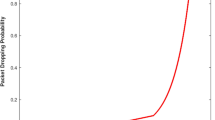Abstract
Active queue management schemes are used to reduce the number of dropped packets at the routers. Random early detection uses dropping probability which is calculated based on the average queue size. Further it is modified according to the value of the count indicating the number of unmarked packets that have arrived after a marked packet. The impact of random variable i.e. number of packets arrived after a marked packet over the dropping pattern is investigated. The proposed model achieves smooth dropping pattern which results in improvement of quality of service parameters. A new model for dropping probability is proposed with different dropping function. The effect of new dropping probability results in the increase of the throughput and reduction of the expected end-to-end delay. An important finding is that the choice of modified dropping function significantly affects the performance measures of the networks.



















Similar content being viewed by others
References
Floyd, S., & Jacobson, V. (1993). Random early detection gateways for congestion avoidance. IEEE/ACM Transactions on Networking, 1(4), 397–413.
Floyd, S., Gummadi, R., & Shenker, S. (2001). Adaptive RED: An algorithm for increasing the robustness of RED’s active queue management, Berkeley, CA. http://www.icir.org/floyd/papers.html. Accessed 23 Feb 2017.
Hollot, C. V., Misra, V., Towsley, D., & Gong, W. (2001). On designing improved controllers for AQM routers supporting TCP flows. In Proceedings of IEEE INFOCOM (pp. 1726–1734).
Hollot, C. V., Misra, V., Towsley, D., & Gong, W. (2002). Analysis and design of controllers for AQM routers supporting TCP flows. IEEE Transactions on Automatic Control, 47(6), 945–959.
Feng, G., Agarwal, A. K., Jayaraman, A., & Siew, C. K. (2004). Modified RED gateways under bursty traffic. IEEE Communications Letters, 8(5), 323–325.
Feng, C. W., Huang, L. F., Xu, C., & Chang, Y. C. (2017). Congestion control scheme performance analysis based on nonlinear RED. IEEE Systems Journal, 11(4), 2247–2254.
Adams, R. (2013). Active queue management: A survey. IEEE Communations Surveys and Tutorials, 15(3), 1425–1476.
Bhatnagar, S., Patel, S., & Karmeshu (2018). A stochastic approximation approach to active queue management. Telecommunication Systems, 68(1), 89–104.
Otero, A. S., & Atiquzzaman, M. (2011). Adaptive localized active route maintenance mechanism to improve performance of VoIP. Journal of Communications, 6(1), 68–78.
Narman, H., Hossain, M. S., & Atiquzzaman, M. (2015). Management and analysis of multi class traffic in single and multi-band systems. Wireless Personal Communications, 83(1), 231–258.
Misra, S., Tiwari, V., & Obaidat, M. S. (2009). LACAS: Learning automata-based congestion avoidance scheme for healthcare wireless sensor networks. IEEE Journal on Selected Areas in Communications, 27(4), 466–479.
Misra, S., Oommen, B. J., Yanamandra, S., & Obaidat, M. S. (2010). Random early detection for congestion avoidance in wired networks: The discretized pursuit learning-automata-like solution. IEEE Transactions on Systems, Man and Cybernetics, Part B, 40(1), 66–76.
Domzal, J., Wojcik, R., Cholda, P., Stankiewicz, R., & Jajszczyk, A. (2016). Efficient congestion control mechanism for flow-aware networks. International Journal of Communication Systems, 29(4), 787–800.
Wang, J., Rong, L., & Liu, Y. (2008). A robust proportional controller for AQM based on optimized second-order system model. Computer Communications, 31(10), 2468–2477.
Karmeshu, Patel, S., & Bhatnagar, S. (2017). Adaptive mean queue size and its rate of change: Queue management with random dropping. Telecommunication Systems, 65(2), 281–295.
Acknowledgements
The author would like to thank Prof. Karmeshu for his useful suggestions and guidance. The help provided by him is highly acknowledged. It will not be possible to complete this paper without his support and time to time discussion with him. We are thankfull to the distinguished referee for their comments and suggestions.
Author information
Authors and Affiliations
Corresponding author
Additional information
Publisher's Note
Springer Nature remains neutral with regard to jurisdictional claims in published maps and institutional affiliations.
Rights and permissions
About this article
Cite this article
Patel, S., Karmeshu A New Modified Dropping Function for Congested AQM Networks. Wireless Pers Commun 104, 37–55 (2019). https://doi.org/10.1007/s11277-018-6007-8
Published:
Issue Date:
DOI: https://doi.org/10.1007/s11277-018-6007-8




